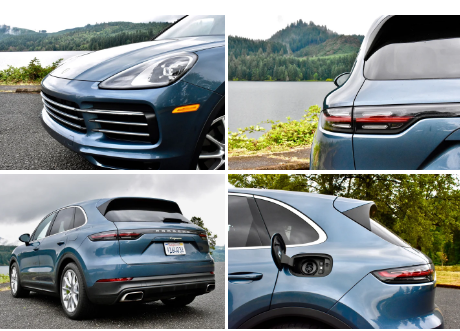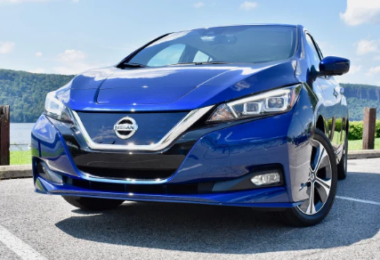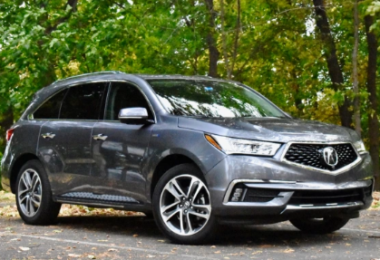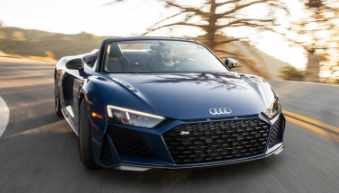Porsche purists howled when the Cayenne was debuted in 2003. It did seem like a leap at the time for a carmaker that had previously exclusively produced sports cars to introduce an SUV. The Cayenne, however, has overtaken the German company’s classic sports cars as a pillar of its inventory.

In 2014, Porsche took things one step further by releasing a plug-in hybrid powertrain for the Cayenne. An updated 2019 Porsche Cayenne E-Hybrid is about to go on sale as part of the third-generation Cayenne lineup, so it appears that notion was successful as well. The goals set by Porsche for this most recent plug-in hybrid are equally as high-calibre.
With a starting price of $81,150 (including a required destination fee), Porsche offers SUV practicality and efficiency without compromising performance. Additionally, the most recent Cayenne E-Hybrid must compete with plug-in hybrid SUVs from brands like Volvo, BMW, Land Rover, and others. That’s too much to ask of one car.
Identical Porsche style
The Cayenne E-Hybrid does not want to highlight its environmental credentials the way some plug-in hybrids do. The E-Hybrid has the same exterior design as the standard Cayenne, save for bright green brake calipers, trim for the badging, which may be removed upon request, and a charge port. This is comparable to other high-end plug-in hybrid SUVs like the Volvo XC90 T8, BMW X5 xDrive40e, and Land Rover Range Rover Sport P400e. All of these cars are thought of as variations of the midsize SUVs made by their respective manufacturers rather than separate models. People will notice that you’re driving a Porsche before they realize that you’re driving a plug-in hybrid, at least in the case of the Cayenne.
The Cayenne E-interior Hybrid’s design is consistent with its exterior, which is not always a bad thing. The upright dashboard and central tachometer, like those of other Cayenne models, are Porsche 911-inspired. To start the E-Hybrid, you can even flick a key-shaped switch that is placed in the customary Porsche location to the left of the steering wheel. These minor details give the Cayenne’s interior a little extra personality and help set it apart from rival premium SUVs.
However, there is more to the interior design than just fan service. A 12.3-inch touchscreen infotainment system with excellent graphics is featured in the Cayenne E-Hybrid. Porsche has Android Auto compatibility, but not Apple CarPlay (that may change soon). Thumb wheels on the steering wheel spokes are used to control the digital displays that may be reconfigured to either side of the central tachometer. The displays indicate information such as how much energy is being recovered during regenerative braking as well as the flow of power from the gasoline engine and battery pack.
The Cayenne really aids in battery recharging when you select its most aggressive setting.
The inside is a pleasant space overall, but a lot depends on how it is furnished. The optional 14-way and 18-way power adjustable sport seats were wonderful since they provided strong side bolstering, a cozy feeling, and a massaging feature. The mixture was ideal for the Cayenne’s purpose in life. Although comfortable, the standard seats lacked the bolstering needed to keep the driver in position during sharp turns—something the Porsche emblem promotes. The absence of a standard power-adjustable steering column in a car that costs around $80,000 and is presumably intended for driving aficionados also struck us as unusual. Setting the steering wheel and seat in the proper positions is the first step to having a pleasant driving experience, and the steering column’s power adjustment makes this process much simpler.
Practically speaking, the E-Hybrid provides a little less cargo room than certain other Cayenne models. This is due to the battery pack’s location underneath the cargo floor. However, the change isn’t really apparent in the real world. The cargo floor in other Cayenne models is slightly below the level of the tailgate, however it is flush with the lip of the tailgate in the E-Hybrid. Greater loading and unloading convenience will probably more than make up for the reduced cargo space.
Although the BMW X5 and Volvo XC90 plug-in hybrid models have more luggage room, it’s impossible to directly compare the passenger volume of the two vehicles because Porsche withheld a full set of interior dimensions. The Cayenne only has five seats, whereas the Volvo XC90 is available in a seven-seater configuration.
Taking over assassin
SUVs must have a roomy interior and adequate storage space, but the Cayenne E-Hybrid stands out for its driving experience. It was always going to be odd to find a Porsche SUV with a plug-in hybrid drivetrain, but the E-Hybrid exceeded expectations in unexpected ways. The Cayenne E-Hybrid delivers Porsche-caliber driving qualities in an efficient package, but the manner in which it does so is impressive. All you have to do is put your foot down thanks to the intricate powertrain’s flawless operation and the numerous connected technological features.
The Cayenne E-engine Hybrid’s combines an electric motor and 14.1 kilowatt-hour lithium-ion battery pack with a 3.0-liter turbocharged V6 and an eight-speed automatic transmission (not the PDK dual-clutch gearbox seen in some other Porsche models). All four wheels receive the combined 455 horsepower and 516 pound-feet of torque produced by the V6 engine and electric motor.
A knob on the steering wheel controls how much of the vehicle is powered by fuel and how much by electricity. As long as the battery pack has enough energy, the Cayenne will automatically switch to E-Power mode, which only uses the electric motor. While Sport and Sport Plus use both forms of propulsion in the pursuit of speed, Hybrid Auto combines gasoline and electric drive. Similar to the kickdown switches in traditional automatic-transmission automobiles, the Cayenne’s right pedal, when pressed past a certain detent point, starts the V6 engine when the vehicle is powered only by electricity. Compared to the Bentley Bentayga Hybrid from Porsche’s sister brand, we noticed that the detent was significantly further into the pedal’s travel, making it simpler to maintain an all-electric cruise. Porsche claims that the Cayenne can travel up to 83 mph with only electric power.
The interior was pleasant to be in all around. However, a lot relies on the setup.
With launch control active, Porsche claims the Cayenne E-Hybrid will accelerate from 0 to 60 mph in 4.7 seconds and have a top speed of 157 mph. That is far faster than the plug-in hybrid versions of the BMW X5, Range Rover Sport, and Volvo XC90, even though none of those vehicles have launch control. However, that demonstrates Porsche’s priorities. Although we were unable to test launch control, just starting to move is thrilling enough. Although we’ve driven a lot of other cars with rapid torque electric motors, the Cayenne E-Hybrid made us feel as though we were experiencing it for the first time.
The Cayenne E-Hybrid also includes a “Sport Response” button that offers a 20-second power boost as if that weren’t enough. Although it could appear to be a gimmick, one of the most crucial daily uses of car performance is passing slower moving vehicles. You can quickly pass those slow pokes by pulling into the overtaking lane, pressing the button (placed on the drive-mode knob).
The Cayenne E-Hybrid excels in a variety of driving situations. Although it is a large, heavy SUV, it corners like a sports car. Porsche Dynamic Chassis Regulate is an add-on that can be used to control body control in addition to the active suspension that is standard. With both, the Cayenne maneuvers around curves with ease. It simply follows the road like a slot car when you aim it in the appropriate direction. Porsche also offers carbon-ceramic brakes, rear-wheel steering, and rear-wheel drive (which turns all four wheels in the same way above 49 mph and the rear wheels in the opposite direction up to 49 mph) (cast-iron brakes are standard). The driver only needs to turn the drive-mode knob into Sport or Sport Plus mode to switch the Cayenne from a comfy cruiser to a corner-carving machine. It’s true that letting the car do all the work reduces some of the enjoyment of driving, but if you want more involvement, you can always purchase a Cayman.
The useful information
Reduced fuel consumption is the primary benefit of a plug-in hybrid like the Cayenne E-Hybrid over a traditional SUV, but EPA estimates of the Porsche’s fuel efficiency and electric range are not yet available. The trip computer in the car indicated that during the course of a day of (admittedly aggressive) driving, we got 21.9 mpg. The amount of time a plug-in hybrid spends operating on electric power determines its level of efficiency, as is the case with all plug-in hybrids. To get the most out of the E-Hybrid, it must be periodically charged and used solely on electricity.
Standard onboard charging capacity is 3.6 kW, although customers have the option to upgrade to a quicker 7.2 kW charger. Porsche does not, however, provide a DC fast-charging alternative. The E-Charge and Sport Plus modes on the Cayenne allow for the limited on-the-go electricity recovery. Yes, when the Cayenne is set to its most aggressive level, it actually aids in battery recharging. The faster way to regain energy is in Sport Plus mode, but because the gasoline engine is working harder, it is also less efficient. We were able to regain three miles of electric range in roughly 10 minutes of downhill driving, even in the slower E-Charge mode.
Porsche provides a 12-year corrosion warranty in addition to a four-year, 50,000-mile warranty. The initial dealership maintenance on the car is also covered by the automaker. Although the E-Hybrid is a new model, Consumer Reports has given earlier Cayenne iterations worse than average dependability ratings. Porsche was rated quite poorly as a brand in the most recent J.D. Power Initial Quality Study. There are currently no public crash test results from the National Highway Traffic Safety Administration (NHTSA) or Insurance Institute for Highway Safety (IIHS).
Summary
The 2019 Cayenne E-Hybrid was designed to be a three-in-one car by Porsche. The most recent Cayenne of the third generation was created to be a useful SUV and an effective plug-in hybrid while yet having the spirit of a sports vehicle. Until you get in the driver’s seat, it’s difficult to think that something like that could be possible.
The Cayenne E-Hybrid is a superbly refined luxury car with a high-quality interior and outstanding entertainment system, perfect for commuting or cruising in traffic. However, the same might be said of rival luxury plug-in hybrid SUVs. Due to its additional luggage room and available third row seat, the Volvo XC90 T8 is undoubtedly the superior SUV. New iterations of the plug-in hybrid variants of the BMW X5 and Mercedes-Benz GLE may also outperform the Cayenne in terms of utility and luxury.
But when you put your foot down and point the nose into a corner, the Porsche reacts in a way that no competitor can match. When you desire speed, the Cayenne E-Hybrid is quick, but it doesn’t force you to make any sacrifices when you don’t.
How DT would set up this vehicle
The 2019 Porsche Cayenne E-Hybrid that we envision would come with a number of add-ons. We would choose the optional 7.2-kW onboard charger and replace the regular front seats with the 18-way power-adjustable sport seats. We would also include rear-wheel steering, carbon-ceramic brakes, and Porsche Dynamic Chassis Control. Porsche hasn’t provided pricing for each option, but when combined, they will represent a sizable premium above the Cayenne E-$81,150 Hybrid’s starting price.
Do you need one?
Yes. The Cayenne E-Hybrid is an excellent all-around vehicle but is not inexpensive. It has the utility of an SUV and the increased efficiency of a plug-in hybrid drivetrain. The Porsche DNA is obvious, even though the driving experience isn’t as pure as it would be in, say, a Boxster.
You can also check 2019 Hyundai Elantra GT N-Line review







